| |
Further results
on the societal iterated prisoner's dilemma
Toby Ord
Introduction
Several years ago, I did some research on a new multiple player
variant of the iterated prisoner's dilemma (IPD). In this variant,
which I named Societal Iterated Prisoner's Dilemma (SIPD),
the game consists of a number of rounds in which each of the n
players simultaneously choose to cooperate or to defect on
each of the other players. At the end of the round, the players
get a score for each of their interactions according to the standard
rules for the prisoner's dilemma and then continue to the next round.
This would be equivalent to the standard Round Robin Iterated
Prisoner's Dilemma (RR-IPD) if not for one important difference:
all the interactions from the past rounds are common knowledge.
This difference opens up a great many strategies which are impossible
in the two standard variants of multiple
player prisoner's dilemma. For example, an exploitative player could
defect on all those who have failed to retaliate when defected on
by others. Or, alternatively, a player could help enforce cooperation
by defecting on those who defect on others without provocation.
Thus, while all interactions are still pair-wise, there are strategies
which exhibit interesting social behaviours.
Most of the results of my research can be found in (Ord
and Blair 2002), and I strongly encourage you to read that paper
before continuing with this note. After writing that paper, I continued
researching SIPD for a brief period and found a few more interesting
results, which I feel are worth sharing here.
As we saw, peacekeeping strategies have considerable promise
for fostering the rise of cooperation within a group by jointly
punishing those who exploit others. Moreover, similar behaviours
are seen in real life, such as in trade sanctions and police action.
However, as noted, a problem arises when we consider the motivation
for such peacekeeping. It is better (for the society) to have peacekeepers
around, but better for an individual to not be a peacekeeper and
to instead stay out of other players' conflicts like TFT does. As
I mentioned in the paper, this is a kind of meta level prisoner's
dilemma. To see how this works in practice, I shall again use some
graphs of evolutionary tournaments (where there are populations
of each strategy and these vary over time in accordance with their
performance).
First recall the following two graphs from the paper:
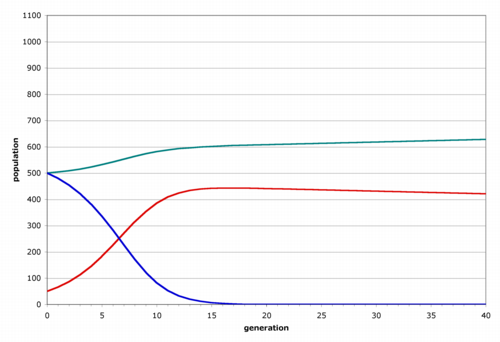
The above tournament begins with large populations of TFT (teal)
and All-C (blue), as well as a small population of Spiteful-Bullies
(red). The Spiteful-Bullies score very well initially at the expense
of the All-Cs. This leads to the Spiteful-Bullies getting a strong
hold in the population while eliminating the All-Cs. TFT gains population
due to out-performing the All-Cs, but the gain is much smaller than
that of the Spiteful-Bullies.
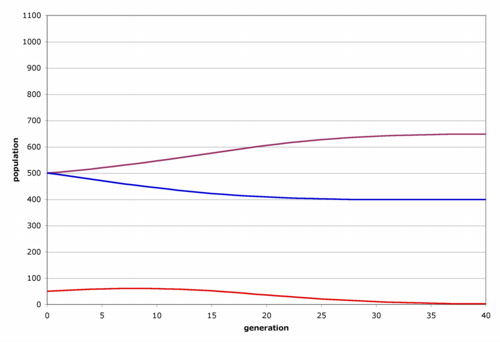
When the TFTs are replaced by Police (purple), things are quite
different. The Police serve a peacekeeping role, retaliating on
the Spiteful-Bullies when they exploit the All-Cs. This leads to
the extinction of the Spiteful-Bullies and an overall small gain
for the Police. However, while the Police gain about as much in
population as the TFTs did, they were actually having much worse
scores during this period, since they were having long periods of
mutual defection with the Spiteful-Bullies. The reason that they
gain is just that every other strategy is also doing quite poorly
in this situation. This becomes very clear if we now replace 100
of these Police with TFTs:
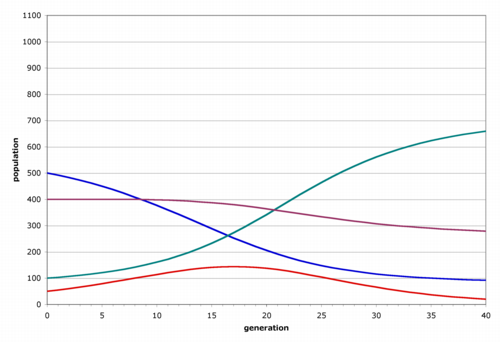
Here the 400 Police still manage to keep the Spiteful-Bullies from
gaining control (although it is a close thing). However, their peacekeeping
took its toll on their scores, letting the TFTs gain a great deal
of population. The TFTs get the benefits of having the Police in
the population and pay none of the price.
As remarked in the paper, one way to keep the Police present in
the population is to eliminate this meta-level prisoner's dilemma,
through meta-peacekeeping: having strategies that defect
on a strategy like TFT which does not perform a peacekeeping role.
We can indeed come up with strategies which are both peacekeepers
and meta-peacekeepers, but even this just shifts the problem up
another level. For in a population with meta-peacekeepers, peacekeepers,
TFTs, the meta-peacekeeper population will decay into regular peacekeepers
(to avoid having mutual defection with TFT) and then these will
decay into TFTs. This is not merely a problem within the evolutionary
framework that I am using here (though it does show up very clearly
in this way). It is a general problem in organising people to implement
sanctions against exploitative parties.
Absolutist
What we really need is a strategy which is a peacekeeper, a meta-peacekeeper,
a meta-meta-peacekeeper and so on. Rather surprisingly, there exists
such a strategy which is expressible in the strategy specification
language that I have been using. Moreover, it is very simply expressible.
Continuing with the tradition of rather anthropomorphised strategy
names, I call this strategy Absolutist.
Absolutist:
Defect on c iff c has
ever cooperated with someone when you defected, or vice versa.
In the first order language that I used in the paper to formally
define strategies, we can define absolutist as follows:
∃t ∃j
(
D(r, j, t) ∧ ¬D(c, j, t)
∨
¬D(r, j, t) ∧ D(c, j, t)
)
Or, if we let ⊕ denote 'exclusive or', then the strategy is
simply:
∃t ∃j D(r, j, t) ⊕ D(c, j, t)
Since nothing has happened before the first round, Absolutists will
initially cooperate with everyone. On the second round, they cooperate
with everyone who cooperated with all and defect on those who defected
on anyone. In this they are performing a peacekeeping role. On the
third round, they again defect on anyone who didn't act like they
have done so far: thus they defects on those who did not perform
this kind of peacekeeping and are thus meta-peacekeepers...
Now note that Absolutist is a loyal strategy for it can
never defect on another player who uses the same strategy. Interestingly,
it is also the minimal loyal strategy: it is impossible
for any strategy to defect more often than Absolutist and yet still
be loyal. We can see this because Absolutist defects on someone
as soon as they do anything differently and never stops defecting
on them after that.
Note also that Absolutist is an unforgiving strategy for
it never stops defecting on someone once it begins. In this it is
like Grim (which happens to be the minimal individually nice strategy).
In contrast, Police is a forgiving peacekeeping strategy.
Absolutist is not individually nice or communally nice
for it can defect on strategies like All-C which never themselves
defect.
So how does Absolutist fare? Consider the previous tournament with
400 Police, 100 TFTs and 50 Spiteful-Bullies. Lets replace the 400
Police with 400 Absolutists:
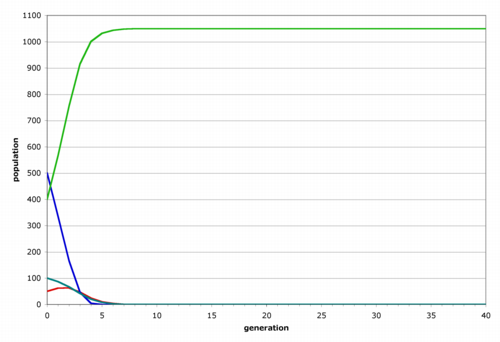
The peacekeeping of the Absolutists (green) prevents the Spiteful-Bullies
from gaining a foothold, and yet there is no decay of Absolutists
into TFTs. Instead, the Absolutists come to completely dominate
the population within 10 generations. Moreover, this success continues
even when the initial population is greatly reduced. The graph below
shows the results of a mere 100 TFTs in the population with the
All-Cs and Spiteful-Bullies:
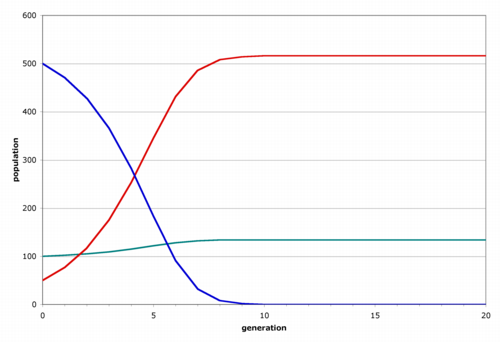
Here the TFTs survive but do not flourish, while the Spiteful-Bullies
come to dominate the population.
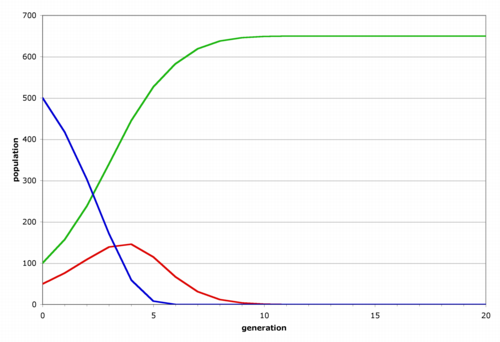
If the TFTs are replaced by Absolutists (as above), they do remarkably
well, completely eliminating all other strategies from the population.
As discussed above, Absolutists defect on a strategy continually
once they behave differently. In the above mix of strategies this
happens after the second round of each game. Thus the Absolutists
are exceptionally clannish, continually cooperating with each other
and continually defecting on everyone else. In doing so, they can
overcome any initially defecting strategy which starts out in lesser
numbers.
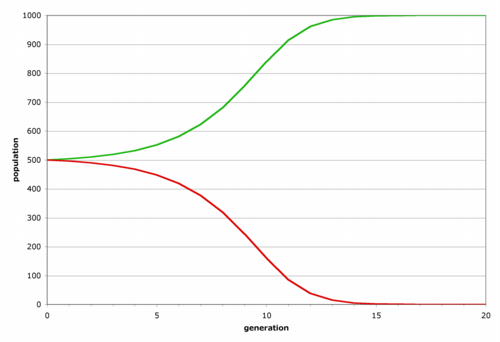
This is seen clearly in the above graph, where 500 Absolutists eliminate
500 Spiteful-Bullies. It begins slowly, but once the Absolutists
get enough of a lead in population, the domination of the population
is very fast.
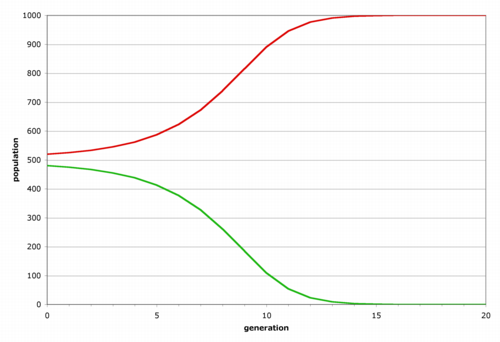
However, when the Absolutists have an initial shortfall in population
(even a very minor one), the Absolutists' propensity for conflict
can lead to their rapid demise.
Further observations concerning Absolutist
In the paper, I contrasted the exploitative strategies like All-D,
Spiteful-Bully and Vulture with the more cooperative strategies
like All-C, TFT and Police. Absolutist does not fit neatly into
this dichotomy. Absolutist is loyal, but not nice in any
of the other technical senses. It defects a lot and is in some sense
intolerant of any other strategies. However, it will not initiate
defection in a population and if it has enough of an initial advantage
in population (as in most of the above tournaments), then it very
quickly leads to a population in which there is no defection at
all. Moreover, this final population is extremely evolutionarily
stable.
I am thus unsure as to whether to consider Absolutist as 'one of
the good guys'. It is a very powerful and interesting strategy whose
presence is very dangerous: its unforgiving nature and propensity
for defection means that it will lead to more defection than any
other loyal strategy within a game of SIPD, but over the course
of an evolutionary tournament, it may well lead to less defection
overall.
Also, Absolutist is only really a tenable strategy when there is
no noise in the players' information or actions. If there is a small
chance of error in information or action, then Absolutists end up
defecting on each other and can never break out of this. The strategy
would have to be modified to take account of the probability that
another strategy was trying to act as an Absolutist and this would
involve considerable additional complexity to the strategy (as well
as being inexpressible in my language). This is also true in cases
of no noise, but where other strategies are allowed to deliberately
involve randomness, or cases where the network of interaction is
weakened so that not all pairs of players interact. Thus, to some
extent, the power of Absolutist is an artifact of this particularly
clean set-up.
We might also consider some small modifications to Absolutist. For
example, could we make a forgiving version of Absolutist? We can
certainly change the definition so that Absolutist doesn't look
at all past rounds, but only the immediately prior one. As it happens,
this doesn't change much in practice as Absolutist has such complex
behaviour that very few other strategies can fall into line with
it after initially doing something differently. There are other
ways in which we could try to make Absolutist forgiving, but they
would involve making quite a few particular choices about the strategy
and I have not had time to follow it all through. Almost certainly
they would require a very expressive language to implement them
and quite some computational resources.
Another possibility is to emulate the so-called Suspicious Tit-For-Tat
(STFT) which is like TFT, but begins by defecting.
Thus:
Suspicious Absolutist:
The same as Absolutist, but begins by defecting.
Interestingly enough, this strategy has almost identical results
to Absolutist in all the tournaments above. Indeed a group of 500
Suspicious Absolutists can beat 500 TFTs in much the same way as
500 Absolutists defeat 500 Spiteful-Bullies.
Suspicious Absolutist is not loyal, but it only defects on those
of the same strategy on one round (the first). We could thus say
that it is loyal in the limit. In sufficient numbers it
eliminates pretty much any other collection of strategies, even
if none of the others will initiate defection. In an evolutionary
tournament, it then leads to a situation of near-perfect cooperation
and even more evolutionary stability than the normal Absolutist.
This strategy is more ethically dubious than Absolutist, but seems
to get even more striking results. I haven't done much analysis
on it, but it is certainly interesting.
In conclusion, SIPD is a model of social interaction that is very
simple and very close to the standard IPD framework. However, it
leads to some surprisingly sophisticated and interesting behaviour,
such as that of Vulture, Police or Absolutist. My research interests
are pulling in other directions at the moment and it is unlikely
that I will get to investigate it further, but I do think that it
would reward further inquiry.
Appendix I: a note on strategies expressed in this first
order language
In my dabbling, and in my observation of evolved strategies, I have
noticed that there are often many ways of achieving a certain behaviour.
For example, I typically write Grim as:
∃t D(c, r, t) c
has defected on r at some time
But it can be expressed just as well using the (apparently rather
useless) term 'D(r, c, p)':
D(c, r, p) ∨ D(r,
c, p) c has defected
on r last round, or r has defected on c
last round
This strategy will begin defecting on c the round after
c first defects on r and will continue to defect
thereafter. Thus, this is just another way of writing Grim: one
that uses r's last action as its memory rather than using
a quantifier.
Also note that there are many strategies that are inexpressible
in this language. Anything too quantitative is inexpressible. For
example, the version of Tit for Two Tats that waits for
two defections before retaliating (no matter how far apart these
come) is inexpressible. I could add predicates (such as B(x,
y) which is true when x is a round that is before
round y), however I resisted this on grounds of the additional
inelegance for such a small gain in expressibility. My language
isn't perfect, but it does have some merits in the way it shows
logical relationships between different strategies and easily combines
multiple strategies into one.
Appendix II: my program and data
dilemma.zip is an archive containing:
the program I used to test the
strategies,
the source code (in C),
some help files on using the
program (from the command line),
the strategies used here (and
many others),
the tournaments run here (with
their results and the graphs).
The program can also perform a form of genetic evolution of strategies.
The strategies are played against each other with the best strategies
going forward to the next generation, along with some new random
strategies and some modified versions of the successful strategies.
My results with this had been very preliminary (which is why none
are included here), but TFT was very successful since it has such
a good strength to complexity ratio. Populations seeded initially
with many Vultures or Absolutists or Suspicious Absolutists were
also very successful in avoiding invasion.
If you would like some help getting this to run, then try emailing
me, though I can't promise to have all that much time to help you.
I wrote this a long time ago and have not programmed much since.
References
Toby Ord and Alan Blair, 'Exploitation
and peacekeeping: introducing more sophisticated interactions to
the iterated prisoner's dilemma', presented at the World
Congress on Computational Intelligence, (Honolulu, 12–17
May 2002).
|
|

